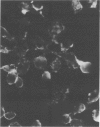Abstract
M protein of influenza A virus was detected with rabbit antiserum by both indirect immunofluorescence and by antibody plus complement-mediated cytolysis on the cell surfaces of both productively and nonproductively infected cells. In contrast, antiserum to nucleoprotein failed to react with unfixed infected cells, but did bind to fixed infected cells, especially in the perinuclear area. Incorporation of antiserum to M protein in a T-cell-mediated cytotoxicity assay produced almost complete abrogation of lysis of H-2-compatible cells infected with an influenza A virus of a subtype which differed from that used to elicit the cytotoxic T cells. However, the antibody did not significantly block 51Cr release from cells infected with the homotypic type A influenza virus. These observations are in accord with the hypothesis that the cross-reactive cytotoxic T-cell responses seen with cells infected by heterotypic influenza A viruses are due to recognition of a common M protein.
Full text
PDF




Images in this article
Selected References
These references are in PubMed. This may not be the complete list of references from this article.
- Biddison W. E., Doherty P. C., Webster R. G. Antibody to influenza virus matrix protein detects a common antigen on the surface of cells infected with type A influenza viruses. J Exp Med. 1977 Sep 1;146(3):690–697. doi: 10.1084/jem.146.3.690. [DOI] [PMC free article] [PubMed] [Google Scholar]
- Blanden R. V., Müllbacher A., Ashman R. B. Different D end-dependent antigenic determinants are recognized by H-2-restricted cytotoxic T cells specific for influenza and Bebaru viruses. J Exp Med. 1979 Jul 1;150(1):166–163. doi: 10.1084/jem.150.1.166. [DOI] [PMC free article] [PubMed] [Google Scholar]
- Braciale T. J. Immunologic recognition of influenza virus-infected cells. I. Generation of a virus-strain specific and a cross-reactive subpopulation of cytotoxic T cells in the response to type A influenza viruses of different subtypes. Cell Immunol. 1977 Oct;33(2):423–436. doi: 10.1016/0008-8749(77)90170-8. [DOI] [PubMed] [Google Scholar]
- Braciale T. J. Immunologic recognition of influenza virus-infected cells. II. Expression of influenza A matrix protein on the infected cell surface and its role in recognition by cross-reactive cytotoxic T cells. J Exp Med. 1977 Sep 1;146(3):673–689. doi: 10.1084/jem.146.3.673. [DOI] [PMC free article] [PubMed] [Google Scholar]
- Bucher D. J., Li S. S., Kehoe J. M., Kilbourne E. D. Chromatographic isolation of the hemagglutinin polypeptides from influenza virus vaccine and determination of their amino-terminal sequences. Proc Natl Acad Sci U S A. 1976 Jan;73(1):238–242. doi: 10.1073/pnas.73.1.238. [DOI] [PMC free article] [PubMed] [Google Scholar]
- Cambridge G., Mackenzie J. S., Keast D. Cell-mediated immune response to influenza virus infections in mice. Infect Immun. 1976 Jan;13(1):36–43. doi: 10.1128/iai.13.1.36-43.1976. [DOI] [PMC free article] [PubMed] [Google Scholar]
- Cerottini J. C., Brunner K. T. Cell-mediated cytotoxicity, allograft rejection, and tumor immunity. Adv Immunol. 1974;18:67–132. doi: 10.1016/s0065-2776(08)60308-9. [DOI] [PubMed] [Google Scholar]
- Effros R. B., Doherty P. C., Gerhard W., Bennink J. Generation of both cross-reactive and virus-specific T-cell populations after immunization with serologically distinct influenza A viruses. J Exp Med. 1977 Mar 1;145(3):557–568. doi: 10.1084/jem.145.3.557. [DOI] [PMC free article] [PubMed] [Google Scholar]
- Ennis F. A., Martin W. J., Verbonitz M. W., Butchko G. M. Specificity studies on cytotoxic thymus-derived lymphocytes reactive with influenza virus-infected cells: evidence for dual recognition of H-2 and viral hemagglutinin antigens. Proc Natl Acad Sci U S A. 1977 Jul;74(7):3006–3010. doi: 10.1073/pnas.74.7.3006. [DOI] [PMC free article] [PubMed] [Google Scholar]
- Ennis F. A., Martin W. J., Verbonitz M. W. Distinct recognition of influenza virus hemagglutinin and H-2 antigens by cytotoxic thymus derived lymphocytes. Dev Biol Stand. 1977 Jun 1;39:373–378. [PubMed] [Google Scholar]
- Laver W. G., Kilbourne E. D. Identification in a recombinant influenza virus of structural proteins derived from both parents. Virology. 1966 Nov;30(3):493–501. doi: 10.1016/0042-6822(66)90125-5. [DOI] [PubMed] [Google Scholar]
- Nabholz M., Vives J., Young H. M., Meo T., Miggiano V., Rijnbeek A., Shreffler D. C. Cell-mediated cell lysis in vitro: genetic control of killer cell production and target specificities in the mouse. Eur J Immunol. 1974 May;4(5):378–387. doi: 10.1002/eji.1830040514. [DOI] [PubMed] [Google Scholar]
- ROTT R., SCHOLTISSEK C. INVESTIGATIONS ABOUT THE FORMATION OF INCOMPLETE FORMS OF FOWL PLAGUE VIRUS. J Gen Microbiol. 1963 Nov;33:303–312. doi: 10.1099/00221287-33-2-303. [DOI] [PubMed] [Google Scholar]
- Schulman J. L., Palese P. Virulence factors of influenza A viruses: WSN virus neuraminidase required for plaque production in MDBK cells. J Virol. 1977 Oct;24(1):170–176. doi: 10.1128/jvi.24.1.170-176.1977. [DOI] [PMC free article] [PubMed] [Google Scholar]
- Virelizier J. L., Allison A. C., Oxford J. S., Schild G. C. Early presence of ribonucleoprotein antigen on surface of influenza virus-infected cells. Nature. 1977 Mar 3;266(5597):52–54. doi: 10.1038/266052a0. [DOI] [PubMed] [Google Scholar]
- Zweerink H. J., Courtneidge S. A., Skehel J. J., Crumpton M. J., Askonas B. A. Cytotoxic T cells kill influenza virus infected cells but do not distinguish between serologically distinct type A viruses. Nature. 1977 May 26;267(5609):354–356. doi: 10.1038/267354a0. [DOI] [PubMed] [Google Scholar]



